Earth Pictures From Space: Landsat Satellite Legacy
The First Landsat
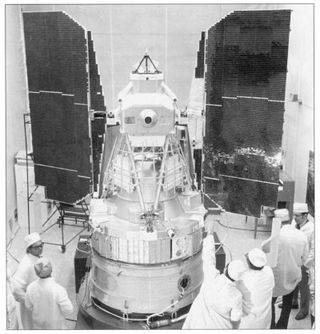
The first Landsat satellite - ERTS-1. It launched on July 23, 1972.
Landsat 1: First Earth Views
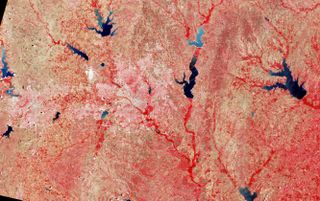
The first fully operational Landsat image taken on July 25, 1972, inaugurating a 40-year run when the first satellite was known as the Earth Resources Technology Satellite, or ERTS.
Landsat Earth Images Then and Now
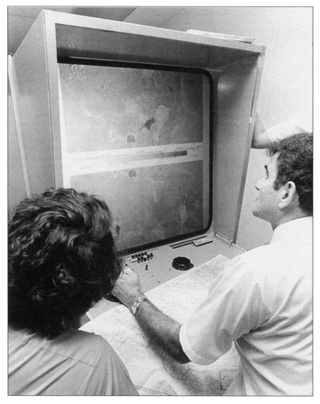
Scientists in 1972 viewing a Landsat enlargement on a special machine in the control center. Now Landsat data is available to everyone with an Internet connection, for free. Posted July 23, 2012.
Landsat Mission Timeline
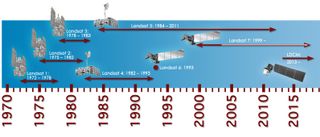
Timeline showing lifespans of the Landsat satellites.
A Shrinking Aral Sea

The Aral Sea in Central Asia began disappearing in the 1960s because of the diversion of its two feeder rivers for agriculture. This series of images illustrates unintended consequences of water management decisions. From left to right, the images were produced in 1977, 1998 and 2010.
International Borders: Mexico and Guatemala
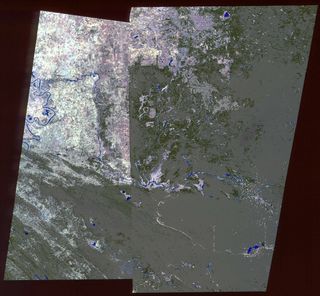
In 1988, the first publicized Landsat image of the Mexico-Guatemala border showed clear-cut forest in Mexico and untouched trees in Guatemala. This image had a profound impact on the leaders of the two nations and influenced the establishment in 1990 of Guatemala's Maya Biosphere Reserve and other management and conservation efforts in Central America. Here is the original 1988 image of the border produced by Tom Sever and shown to the leaders of Mexico and Guatemala. The western portion is from Landsat 4 as seen on May 20, 1988, and the eastern part is from Landsat 5 on April 14, 1986.
1st Place: Van Gogh from Space Landsat 7 Acquired July 13, 2005

Swirls of yellow streak a deep blue sea around a long island In the style of Van Gogh's painting "Starry Night," massive congregations of greenish phytoplankton swirl in the dark water around Gotland, a Swedish island in the Baltic Sea.
Get the Space.com Newsletter
Breaking space news, the latest updates on rocket launches, skywatching events and more!
2nd Place: Yukon Delta Landsat 7 Acquired September 22, 2002

Countless lakes, sloughs, and ponds are scattered throughout this scene of the Yukon Delta in southwest Alaska.
3rd Place: Meandering Mississippi Landsat 7 Acquired May 28, 2003
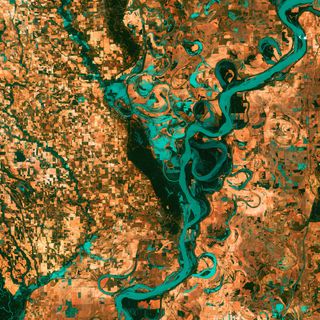
Small, blocky shapes of towns, fields, and pastures surround the graceful swirls and whorls of the Mississippi River, the largest river system in North America.
4th Place: Algerian Abstract Landsat 5 Acquired April 8, 1985

Ridges of wind-blown sand make up Erg Iguidi, an area of ever-shifting sand dunes extending from Algeria into Mauritania in northwestern Africa.
5th Place: Lake Eyre Landsat 5 Acquired August 5, 2006
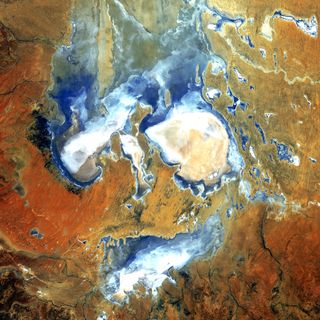
The scary face in this image is actually inundated patches of shallow Lake Eyre (pronounced "air") in the desert country of northern South Australia.
Join our Space Forums to keep talking space on the latest missions, night sky and more! And if you have a news tip, correction or comment, let us know at: community@space.com.

Space.com is the premier source of space exploration, innovation and astronomy news, chronicling (and celebrating) humanity's ongoing expansion across the final frontier. Originally founded in 1999, Space.com is, and always has been, the passion of writers and editors who are space fans and also trained journalists. Our current news team consists of Editor-in-Chief Tariq Malik; Editor Hanneke Weitering, Senior Space Writer Mike Wall; Senior Writer Meghan Bartels; Senior Writer Chelsea Gohd, Senior Writer Tereza Pultarova and Staff Writer Alexander Cox, focusing on e-commerce. Senior Producer Steve Spaleta oversees our space videos, with Diana Whitcroft as our Social Media Editor.
